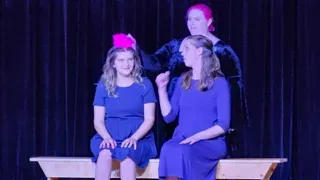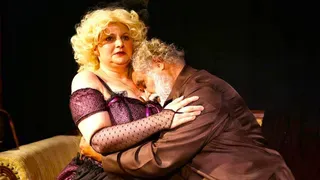July 27, 2013
Ambisexual Stravinsky?
Kilian Melloy READ TIME: 4 MIN.
There's a powerfully good read to be had in Robert Craft's "Stravinsky: Discoveries and Memories" (Naxos Books), whose release was timed to coincide with the 100th anniversary, on May 27, of Igor Stravinsky's most famous composition, "The Rite of Spring," one of the watershed works of modernity. Craft's book drops a bomb that, in the tawdry modern way, could yet overshadow the other Rite thinking that has attended the anniversary.
Calling his revelation "long overdue" yet timely in sense that things have changed, the world has changed, and these things can now be talked about, Craft writes, "It will come a surprise to most people that in the early Diaghilev period Stravinsky was exclusively in an ambisexual phase while writing 'Petrushka' and 'The Rite of Spring.' "
Even without the head-scratchers of "exclusively," "ambisexual" and "phase," "surprise" is a stunner of an understatement predicting the storm of controversy his assertion that Stravinsky had sex with men in the period in which he was composing "The Rite" would stir up, as it has. It would have been a poor calculation for Craft, whose career as a musician and writer, and whose own personal fame, rest on his long association with Stravinsky as colleague and confidant, to steal his master's thunder in the Rite Year. But Craft had to know that his contention, and the raft of evidence of whatever reliability he has supplied to support it, would sell books. Whatever else, Craft is back in the news, right alongside the master.
I'm going to wager right up front that, before crying foul, the experts who doubt the veracity of Craft's claims about Stravinsky's sex with men read Craft's 400-page memoir - or at least the chapter "Amorous Augmentations" - with the same slack-jawed, page-turning, finger-burning fascination I did. True or not, it's a spellbinding story, and at least on its surface none of it seems implausible or distasteful. Men in their 20s, particularly those with libidos like Stravinsky's (Craft says the composer's persisted into his 80s), are known for the range of their sexual activities, and the milieu in which Stravinsky worked at the time - Sergei Diaghilev's Ballets Russes and the Parisian homosexual underground of Les Apaches - would have provided an abundance of opportunity. It would be stranger to think that Stravinsky had not had sex with men then.
Craft maintains that at the time of "The Firebird," Stravinsky was in love with Andrey Rimsky-Korsakov, the son of his famous teacher. He even suggests that Stravinsky may have spent time in Diaghilev's arms. Among the other men with whom Craft alleges he had sexual-romantic relations were Belgian composer Charles Maurice Delage and the fellow composer who introduced the two, Maurice Ravel. "Ravel and Stravinsky were, of all artists, the most successful in concealing their sexuality," Craft writes, following up with one of his most rigorously contested assertions: "The two were time-to-time lovers in the early Diaghilev years."
In no way is Craft teasing the "Was Stravinsky gay?" question. In his Times Literary Supplement essay, purportedly about "The Rite," that appeared just after the book's release, he writes almost offhandedly of Stravinsky's "hyperactive heterosexual philandering." And although there he makes a detailed case for Stravinsky's having had a much greater hand in the making of "The Rite" than was previously thought, he does not argue that a homosexual reading would deepen our understanding of the inscrutable masterpiece.
But neither is there even-handedness, let alone neutrality, in his "exploration" of Stravinsky's sexuality. Even taking into account Craft's 89 years, the language he uses to describe it is not merely arch but implicitly judgmental. What, on the heterosexual front, is philandering, on the man-sex side is sensationally lurid conduct.
"In the spring of 1911 Stravinsky had spent a three-week vacation at Delage's gay agapemone near Paris, not alone but with the notoriously homosexual Prince Argutinsky, whose letters are still in private hands," Craft writes, in the smoky language of the private men's club. "A Russian gentleman who has read this correspondence told me a few months after Stravinsky's death that Argutinsky's letters are 'very compromising to [sic] Stravinsky biography.' In the late summer of 1911 Stravinsky sent to Delage a photograph of himself in the nude with a prominent upwardly mobile nozzle."
The photo is not among the book's gallery of fascinating photos of the composer and his friends. (The physical book also comes with a CD of Craft's pedantic 2007 interpretation of "The Rite" as conductor.)
"Stravinsky: Discoveries and Memories" has been for me the guiltiest of pleasures. Without the scholarly weight of biography, it's a feast of "the good parts," and it greatly fills out our picture of this greatest of 20th-century composers. And it addresses musical matters head-on. It's particularly good in its detailed depiction of Stravinsky's beloved second wife Vera, who also, it seems, had an augmented heterosexual amorous agenda of her own.
But for all the sweetness that only such a memoir can bring, there is, after the controversy it deliberately created, the nagging doubt about how much of it is true. And the language used to depict Stravinsky's sexuality, particularly the sex with men, smacks of judgment and has a disagreeable aftertaste, one that made me wonder how much things really have changed.
Kilian Melloy serves as EDGE Media Network's Associate Arts Editor and Staff Contributor. His professional memberships include the National Lesbian & Gay Journalists Association, the Boston Online Film Critics Association, The Gay and Lesbian Entertainment Critics Association, and the Boston Theater Critics Association's Elliot Norton Awards Committee.







